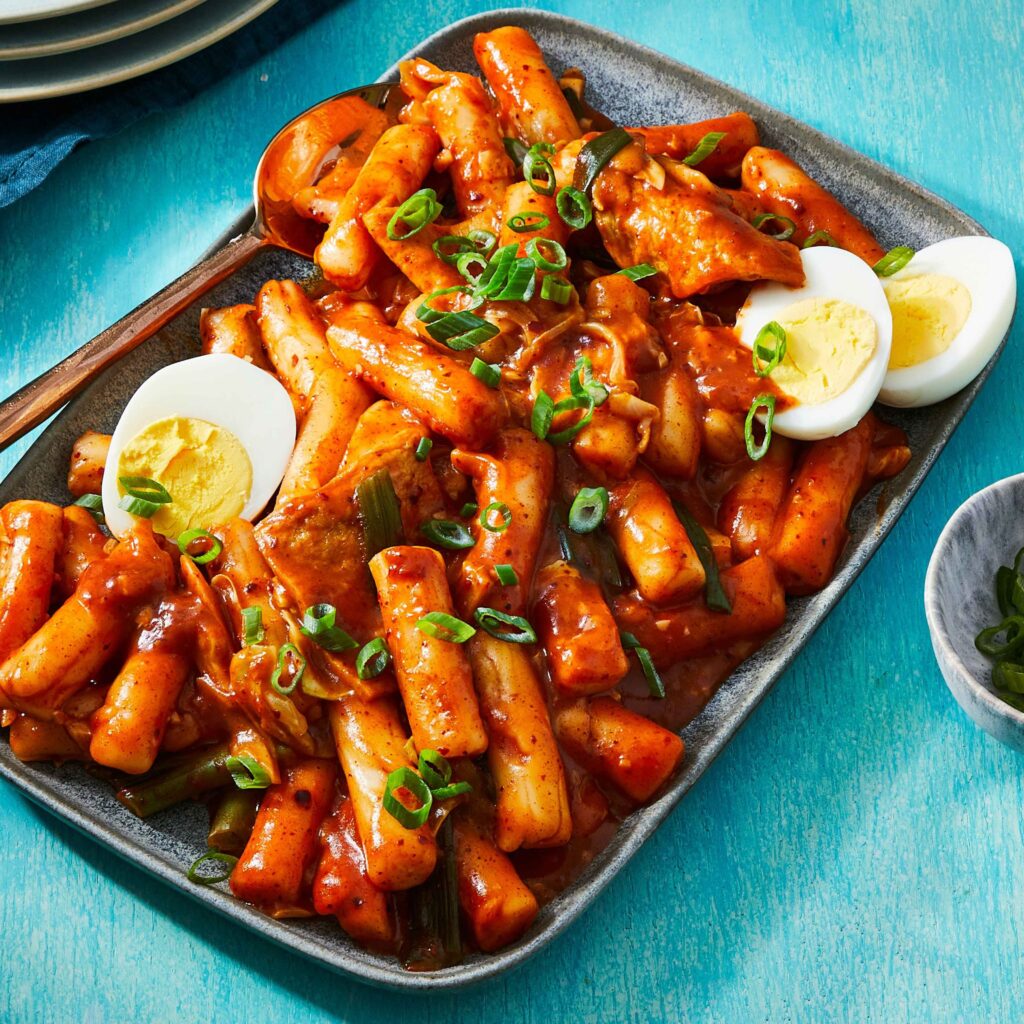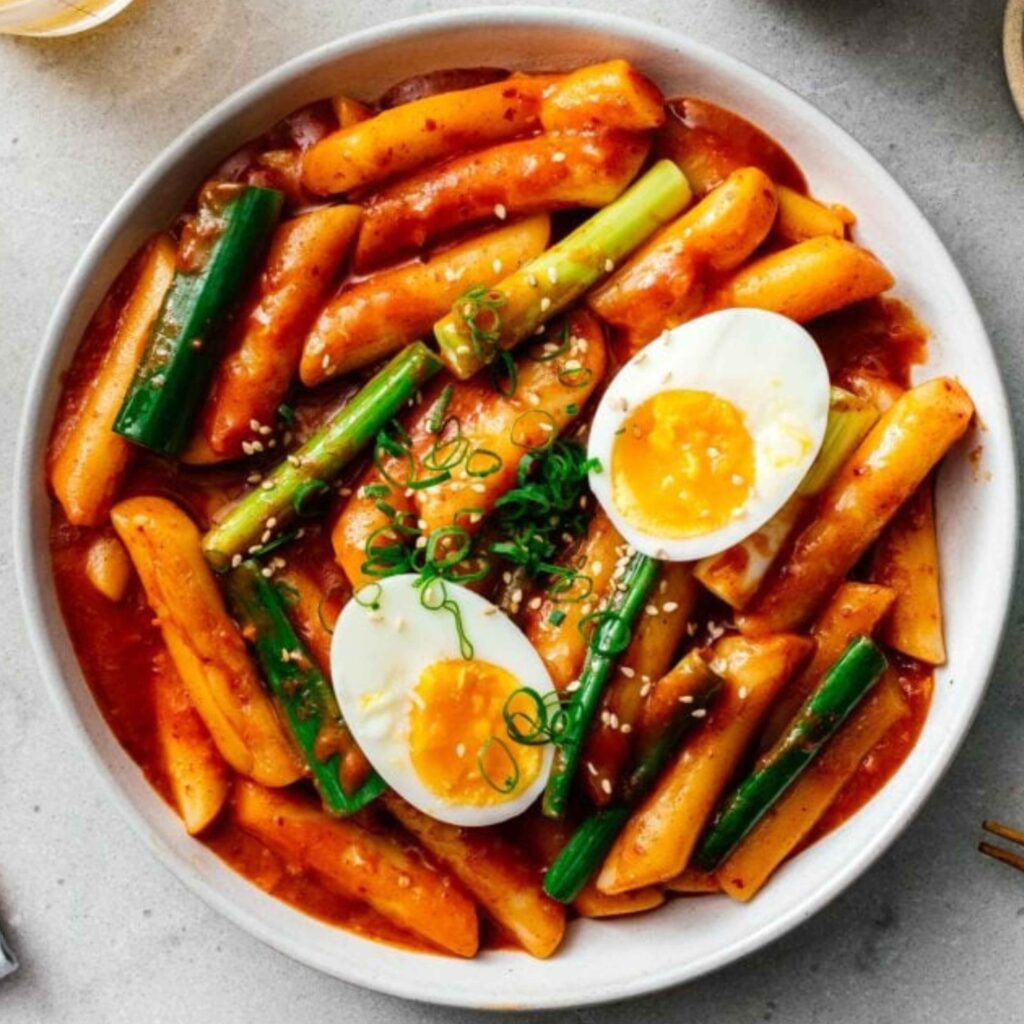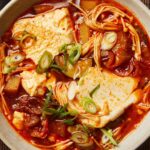
Tteokbokki (Rice cakes)



Introduction and History of Tteokbokki (Rice Cakes): A Timeless Korean Delicacy
In the mosaic of Korean cuisine, Tteokbokki emerges as a beloved culinary delight that has withstood the test of time and captivated the palates of generations. Originating from South Korea, the history of Tteokbokki is a story of flavors, innovation, and cultural tradition.
A Tapestry of Taste
Tteokbokki’s history traces back to the vibrant streets of Korea, where it blossomed as a harmonious fusion of rice cakes and spicy sauce. The term “tteokbokki” refers to chewy rice cakes bathed in a delectable red pepper sauce, capturing the essence of its flavorful composition.
The Signature Sauce
At the core of Tteokbokki lies its iconic red pepper sauce, a blend of fiery gochujang (red chili paste), garlic, and other seasonings. The sauce clings to the chewy rice cakes, creating a symphony of spice, texture, and taste that tantalizes the palate.
A Comforting Tradition
Tteokbokki carries a rich cultural significance as a dish that evokes comfort and nostalgia. It’s a street food staple, often enjoyed during communal gatherings, celebrations, and moments when the heart seeks solace in familiar flavors.
A Culinary Evolution
Throughout its journey, Tteokbokki has evolved to adapt to changing tastes and preferences. Variations include fusion versions that incorporate seafood, cheese, and more, showcasing the dish’s versatility while honoring its traditional roots.
Passed Down Through Time
The history of Tteokbokki is a tale of recipes shared and techniques passed down through families and communities. As parents and grandparents impart their culinary wisdom, the dish evolves while retaining its chewy, spicy essence.
Conclusion
Tteokbokki isn’t just a dish; it’s a passage through Korea’s culinary narrative, from bustling streets to contemporary tables. With its origins in street food stalls and its presence as a comfort food, this dish embodies the essence of both tradition and adaptation. As you savor the chewy rice cakes bathed in the iconic red pepper sauce, you’re not just experiencing a meal; you’re tasting the history, heritage, and culinary creativity that Tteokbokki brings to every delicious bite.
- Serves: 2-3 People
- Prep Time: 10 minutes
- Cooking: 15 minutes
- Difficulties: easy
Ingredients
For Cooking
- 200gTteok (Korean rice cakes), soaked in cold water
- 1/2 cup fish cake slices
- 1/4 cup chopped scallions
- 2 cups water
- 3 tablespoons gochujang (Korean red chili paste)
- 1tablespoon soy sauce
- tablespoon sugar
- tablespoon minced garlic
- tablespoon sesame oil
- tablespoon sesame seeds
- Dash of black pepper
- Optional toppings boiled eggs, sliced cabbage, ramen noodles
For Dressing
Nutritional Information
-
Calories:
250 -
Total Fat
3g -
Saturated Fat
1g -
Cholestero
15mg -
Sodium
800mg -
Total Carbohydrates
53g -
Dietary Fiber
2g -
Sugars
10g -
Protein
5g
Procedure
Conclusion: Tteokbokki is a spicy and delightful dish that captures the heart of Korean street food. Its combination of chewy rice cakes, savory fish cakes, and a bold red sauce creates an unforgettable experience for your taste buds. Whether you’re a spice enthusiast or simply curious about Korean cuisine, Tteokbokki offers a thrilling adventure. Customize it with various toppings or experiment with different types of rice cakes. Share this dish with friends and family and immerse yourself in the flavors of Korea.
-
Mark As Complete
In a saucepan, combine water, gochujang, soy sauce, sugar, and minced garlic. Stir well to create a sauce
-
Mark As Complete
Bring the sauce to a gentle simmer over medium heat.
-
Mark As Complete
Add the soaked rice cakes and fish cake slices to the sauce. Cook, stirring occasionally, until the rice cakes are soft and chewy, about 5-7 minutes.
-
Mark As Complete
Add chopped scallions and sesame oil, then season with black pepper.
-
Mark As Complete
If desired, add boiled eggs, sliced cabbage, or ramen noodles to the mixture.
-
Mark As Complete
Continue to cook for an additional 2-3 minutes until everything is heated through.
-
Mark As Complete
Sprinkle sesame seeds over the dish before serving.
You also might like
No recipe were found.


